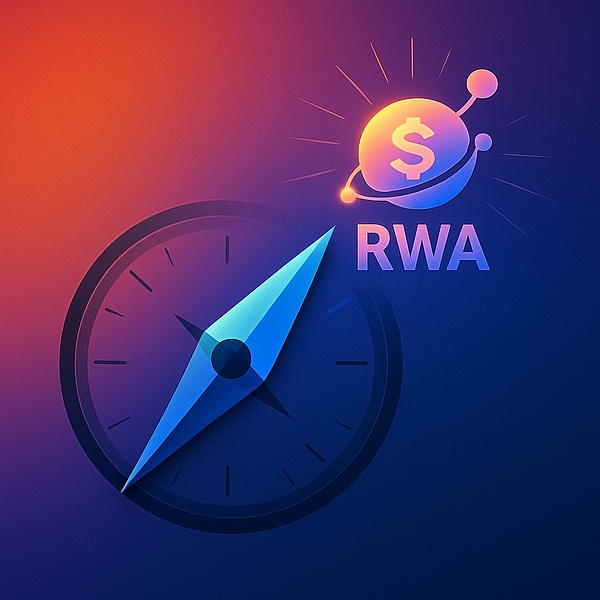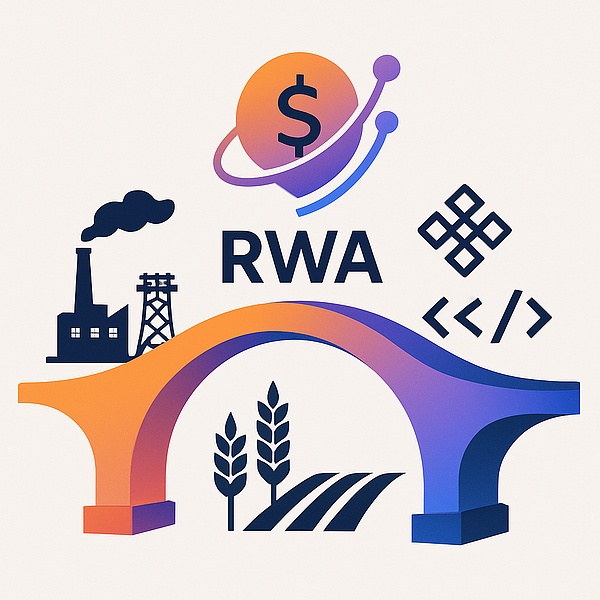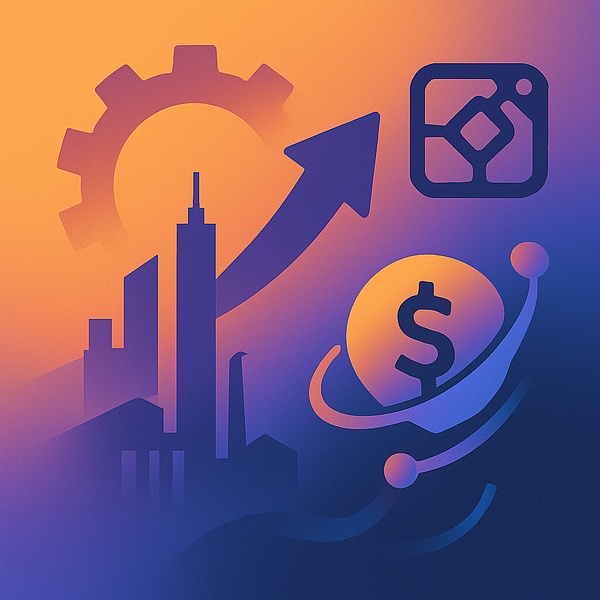——From the policy study meeting, see the way out of RWA.
Introduction: Policy vane, new opportunities for RWA
On July 10, 2025, the Party Committee of the Shanghai State-owned Assets Supervision and Administration Commission held a highly anticipated central group study meeting to conduct in-depth study on the development trends and response strategies of cryptocurrencies and stablecoins. This meeting not only reflects Shanghai's keen insight as a financial center, but also sends a clear signal: China is actively exploring the application of blockchain technology in areas such as asset digitization in the wave of digital economy, which undoubtedly brings unprecedented policy opportunities for the development of RWA (real world asset tokenization).
Against the backdrop of the booming global digital economy, cryptocurrencies and stablecoins, as important components of digital assets, are increasingly influential. RWA, as a bridge connecting traditional finance and the digital world, is becoming a key path to revitalize physical assets and improve financing efficiency. The convening of this meeting by the Shanghai State-owned Assets Supervision and Administration Commission indicates that RWA is expected to usher in a broader development space driven by state-owned assets and state-owned enterprises. This article will deeply interpret the significance of this meeting, explore the intrinsic connection between cryptocurrencies, stablecoins and RWA, and look forward to the future actions of state-owned assets and state-owned enterprises in the field of RWA.

1. Shanghai SASAC meeting: sending positive signals
The 10th Shanghai SASAC Party Committee Central Group Study Meeting was hosted by He Qing, Secretary of the Party Committee and Director of the Municipal SASAC, and invited Li Mingliang, Chief of the Policy Group of Cathay Pacific Haitong Policy and Industry Research Institute, to give a special tutorial report. The meeting deeply discussed the development history, type characteristics, global development strategy and regulatory system of cryptocurrencies and stablecoins, and analyzed the opportunities and challenges they face.
Key points of the meeting:
•Strengthen research and exploration of digital currency: Director He Qing emphasized the need to "adhere to innovation-driven development, maintain a keen sense of emerging technologies, and strengthen research and exploration of digital currency." This shows that the attitude of Shanghai's state-owned assets system towards digital currency has changed from waiting or being cautious in the past to active research and layout, aiming to seize the initiative in the development of the digital economy.
•Explore the application of blockchain technology in asset digitization and other fields: The meeting clearly proposed "adhering to the integration of production and numbers, and exploring the application of blockchain technology in cross-border trade, supply chain finance, asset digitization and other fields". "Asset digitization" is the core connotation of RWA, which directly points out the important strategic position of RWA in the future development of state-owned assets and state-owned enterprises. Through blockchain technology, state-owned assets and state-owned enterprises are expected to revitalize existing assets, optimize asset allocation, and improve operational efficiency.
•Promote the deep integration of science and technology, finance and industry: Director He Qing further pointed out that it is necessary to "improve strategic agility and strategic initiative, further promote the deep integration of science and technology, finance and industry, and better play the important role of state-owned assets and state-owned enterprises in scientific and technological innovation, industrial control and security support". This means that Shanghai state-owned assets and state-owned enterprises will take digital currency and blockchain technology as an opportunity to accelerate the digital transformation of traditional industries and build a more competitive industrial ecology.
Positive signals released by the meeting:
1.Recognition and guidance at the policy level: The convening of this meeting indicates that the local government, especially the state-owned assets system, is deepening its understanding of digital assets such as cryptocurrencies and stablecoins, and is beginning to guide and lay out from a strategic level. This is undoubtedly a major benefit to the entire digital asset industry, especially the RWA field.
2.RWA development ushers in new opportunities: The meeting explicitly mentioned "asset digitization", which indicates that RWA will usher in rapid development driven by state-owned assets and state-owned enterprises. State-owned assets and state-owned enterprises own a large number of high-quality real-world assets, such as infrastructure, real estate, energy, etc. The digitization of these assets will inject huge vitality into the RWA market.
3.The potential of stablecoins in payment and settlement: The report of Cailianshe also pointed out that Hualong Securities Research Report is optimistic about the role of stablecoins as an important payment tool, especially in the context of the upcoming implementation of the Hong Kong Stablecoin Ordinance, which is expected to accelerate the competition in on-chain finance.
This conference not only pointed out the direction for Shanghai state-owned enterprises to explore the field of digital economy, but also laid the foundation for the compliance and large-scale development of RWA in China, indicating that a new era of RWA dominated by state-owned assets may be opened.

Second, cryptocurrency and stablecoin: the cornerstone of the digital economy
Before discussing RWA in depth, it is necessary to understand the cornerstone of the digital economy on which it depends - cryptocurrency and stablecoin. They are not only the value carriers of the digital world, but also the key to promoting the digitization and circulation of assets.
1. Cryptocurrency: Native Assets of the Digital World
Cryptocurrency, such as Bitcoin and Ethereum, is a digital asset built on blockchain technology. They are decentralized, anonymous, and tamper-proof, providing a new way of value transmission and storage for the digital economy. Although its price volatility is large, its underlying technology, blockchain, provides technical support for asset digitization. The emergence of cryptocurrency has challenged the centralized model of the traditional financial system and laid the foundation for building a more open and transparent financial ecosystem.
2. Stablecoins: A bridge between traditional finance and the digital world
A stablecoin is a cryptocurrency designed to maintain price stability, usually by anchoring to a fiat currency (such as the U.S. dollar), a commodity (such as gold), or a basket of assets. The emergence of stablecoins has effectively solved the problem of high price volatility of cryptocurrencies, making them a more reliable medium of exchange and value storage tool in the digital world.
Classification of stablecoins:
•Fiat-collateralized stablecoins: Such as USDT and USDC, which are anchored to fiat currency at a 1:1 ratio and supported by reserves, are the most common types of stablecoins.
•Crypto-collateralized stablecoins: Such as DAI, which maintains price stability by over-collateralizing other crypto assets.
•Algorithmic stablecoins: The supply is adjusted by algorithms to maintain price stability, but the risk is higher.
Stablecoins play a vital role in the RWA field. It provides a stable value scale for the issuance, trading and settlement of RWA, reduces transaction risks and improves market efficiency. For example, when real-world assets are tokenized, they can be traded through stablecoins, thus avoiding the cumbersome process and time cost of traditional fiat currency settlement. The upcoming implementation of the Hong Kong Stablecoin Ordinance also indicates that the global compliance process of stablecoins is accelerating, which will further promote its application and development in RWA and other fields. The development of cryptocurrency and stablecoins provides a solid technical and value foundation for RWA. Together, they constitute the cornerstone of the digital economy and provide unlimited possibilities for the innovation and application of RWA.

3. RWA: A bridge connecting the real economy and the digital world
RWA (Real World Assets) is the product of the deep integration of the digital economy and the real economy. It digitizes and tokenizes valuable assets in the real world, such as real estate, bonds, commodities, intellectual property and even AI computing power, through blockchain technology, so that they can be circulated, traded and managed in the digital world. The core value of RWA: 1. Improved asset liquidity: Traditional physical assets often have poor liquidity and high transaction thresholds. RWA divides large assets into small portions through tokenization, lowers the investment threshold, and can be traded 24/7 around the world, greatly improving asset liquidity.
2.Optimize financing efficiency: The application of blockchain and smart contracts makes the asset issuance, transaction and management processes automated and transparent, reducing intermediate links and manual intervention, thereby significantly reducing financing costs and improving financing efficiency.
3.Expand investment channels: RWA provides traditional investors with a new way to enter the digital asset field, and also provides digital asset investors with a compliant channel to invest in physical assets, broadening the investment boundaries of both parties.
4.Enhance transparency and traceability: The immutability of blockchain ensures the authenticity of asset information and the transparency of transaction records, effectively reduces the risk of fraud and enhances market trust.
The relationship between RWA and cryptocurrency and stablecoin:
•RWA is the "value anchor" of cryptocurrency: The cryptocurrency market has long been questioned for its high volatility. The emergence of RWA provides real-world value support for cryptocurrencies, making them no longer "castles in the air" but "rooted trees" closely linked to the real economy. Through RWA, cryptocurrencies can obtain a wider range of application scenarios and a more stable value foundation.
•Stablecoins are the "transaction medium" of RWA:Stablecoins provide a stable value scale for the issuance, trading and settlement of RWA. In the transaction process of RWA, the use of stablecoins can effectively avoid the price volatility risks of cryptocurrencies and improve transaction efficiency and security. For example, investors can use stablecoins to purchase tokenized real estate shares, or companies can obtain stablecoin financing by issuing tokenized bonds.
The Shanghai State-owned Assets Supervision and Administration Commission meeting emphasized "exploring the application of blockchain technology in areas such as asset digitization", which is precisely because it sees the huge potential of RWA in revitalizing existing assets and optimizing resource allocation. As an important pillar of the national economy, state-owned enterprises have a large number of high-quality physical assets. The digitization of these assets will bring unprecedented development opportunities to the RWA market.

Fourth, Integration and Prospect: What state-owned enterprises have done in the field of RWA
The convening of this meeting by the Shanghai State-owned Assets Supervision and Administration Commission is not only a positive response to digital currency and blockchain technology, but also points out the direction for the deep integration and innovative development of state-owned enterprises in the field of RWA. As the "ballast stone" of the national economy, state-owned enterprises have a large number of high-quality assets. Their actions in the field of RWA will have a profound impact on the entire digital asset market.
Unique advantages of state-owned assets and state-owned enterprises in the field of RWA:
1.Asset scale and quality: State-owned assets and state-owned enterprises have huge physical assets, including infrastructure, land, real estate, energy, transportation, etc., which are all high-quality underlying assets of RWA. The authenticity and compliance of their assets are also more easily recognized by the market.
2.Policy support and compliance: The signal from the Shanghai SASAC meeting indicates that RWA will receive stronger policy support in the field of state-owned assets and state-owned enterprises. The state-owned background also helps RWA projects gain advantages in compliance and reduce regulatory risks.
3.Industry driving effect: State-owned assets and state-owned enterprises occupy an important position in the national economy. Their exploration and practice in the field of RWA will drive the common development of upstream and downstream enterprises in the relevant industrial chain and form economies of scale.
4.Technology and talent reserves: Many state-owned assets and state-owned enterprises have accumulated certain experience in digital transformation and have certain technology and talent reserves, which provide a foundation for the implementation of RWA.
Specific actions of state-owned assets and state-owned enterprises in the field of RWA
•Activate existing assets:Through RWA, idle or inefficient state-owned assets can be tokenized to realize asset securitization and liquidity improvement, bringing new financing channels and development opportunities for enterprises. For example, infrastructure projects and commercial real estate can be tokenized to attract social capital to participate in investment.
•Optimize financing structure: RWA can provide state-owned assets and state-owned enterprises with more flexible and efficient financing methods, reduce financing costs, and optimize debt structure. Raise funds directly from global investors by issuing tokenized bonds, equities, etc.
•Promote the digital transformation of the industry: The practice of RWA will accelerate the digital transformation of state-owned assets and state-owned enterprises, prompting them to apply blockchain technology in asset management, supply chain finance, cross-border trade and other fields to improve operational efficiency and competitiveness.
•Build a digital economic ecosystem: State-owned assets and state-owned enterprises can play a leading role, cooperate with technology companies, financial institutions, etc., to jointly build an RWA ecosystem and promote the healthy development of the digital asset market.
Future Prospects and Challenges:
The future of RWA in the field of state-owned assets and state-owned enterprises is full of opportunities, but also faces challenges. At the policy level, the legal status and regulatory framework of RWA need to be further clarified to ensure compliant development. At the technical level, issues such as blockchain performance, security and interoperability need to be addressed. At the market level, market education needs to be strengthened to enhance investors' awareness and confidence in RWA. However, with the active exploration of local governments such as the Shanghai State-owned Assets Supervision and Administration Commission, and the huge potential of RWA itself, we have reason to believe that state-owned assets and state-owned enterprises will play an increasingly important role in the field of RWA and jointly promote the digital economy to new heights.

Conclusion: Building a new digital asset ecosystem
The Shanghai SASAC's central group study meeting on cryptocurrency and stablecoins is not only an important step taken by Shanghai in the field of digital economy, but also a booster for the future development of RWA in China. The meeting clarified the positive exploration attitude towards digital currency and emphasized the application of blockchain technology in the field of asset digitization, which undoubtedly provides policy guidance and development space for state-owned assets and state-owned enterprises to participate in RWA.
As a bridge connecting the real economy and the digital world, the value of RWA lies in revitalizing existing assets, improving financing efficiency, and expanding investment channels. As the cornerstone of the digital economy, cryptocurrencies and stablecoins provide technical and value support for the issuance, trading and settlement of RWA. The integration of the three will jointly build a more efficient, transparent and inclusive new digital asset ecosystem.
Looking to the future, we look forward to seeing more state-owned enterprises actively embrace RWA and use it as an important tool to promote industrial upgrading and achieve high-quality development. At the same time, we also call on relevant departments to speed up the improvement of RWA's laws, regulations and regulatory systems to safeguard the healthy development of RWA. RWA Pilot will continue to pay attention to policy trends and market frontiers, provide professional RWA consulting services to enterprises and investors, and jointly welcome the arrival of the digital asset era.
 Weatherly
Weatherly








